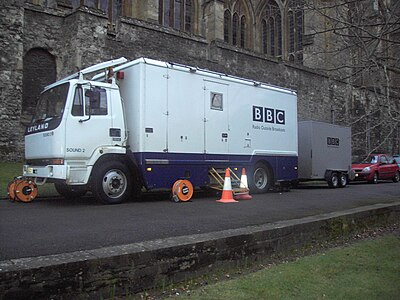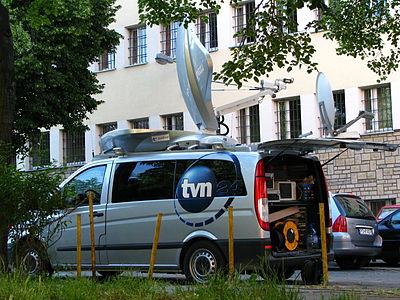Outside broadcasting
This article needs additional citations for verification. (June 2018) |

Outside broadcasting (OB) is the electronic field production (EFP) of television or radio programmes (typically to cover television news and sports television events) from a mobile remote broadcast television studio. Professional video camera and microphone signals come into the production truck for processing, recording and possibly transmission.
Some outside broadcasts use a mobile production control room (PCR) inside a production truck.
History
This section needs expansion with: additional information on early broadcasts, and history beyond 1953. You can help by adding to it. (November 2019) |

Outside broadcasts have been taking place since the late 1920's.[1] The first large-scale outside broadcast was the televising of the Coronation of George VI and Elizabeth in May 1937, done by the BBC's first Outside Broadcast truck, MCR 1 (short for Mobile Control Room).[2]
After the Second World War, the first notable outside broadcast was of the 1948 Summer Olympics.[3][4] The Coronation of Elizabeth II followed in 1953, with 21 cameras being used to cover the event.[5][6]
Modern applications
Modern outside broadcasts now use specially designed OB vehicles, many of which are now built based around IP technology rather than relying on coaxial cable.[7]
There has been an increasing rise in the use of flyaway or flypack Portable Production Units, which allow for an increased level of customisation and can be rigged in a larger variety of venues.[8]
In the past many outside broadcasting applications have relied on using satellite uplinks to broadcast live audio and video back to the studio. While this has its advantages such as the ability to set up anywhere covered by the respective geostationary satellite, satellite uplinking is relatively expensive and the round trip latency is in the range of 240 to 280 milliseconds.[9]
As more venues install fiber optic cable, this is increasingly used.[10] For news gathering, contribution over public internet is also now used. Modern applications such as hardware and software IP codecs have allowed the use of public 3G/4G networks to broadcast video and audio. The latency of 3G is around 100–500 ms, while 4G is less than 100 ms.[11]
Gallery
-
An ABS-CBN OB van transmitting a satellite feed
-
Camera operator working on an outside broadcast of a football match at Wembley Stadium
-
A BBC Radio outside broadcasting van at New College, Oxford
-
An Ikegami camera of ORF at a football match
-
OB for tennis tournament: Extendible-sided production van, satellite dishes, generator truck; see two OB cameras and three announcing booths at top of stadium beyond. Kooyong, Victoria, Australia, 2008
-
Klotz Digital's Vadis DC II mixer for use at a Virgin Radio outside broadcast at the V Festival 2007
See also
References
- ^ "How the BBC took the news outside". BBC News - In Pictures. BBC News. 10 March 2016. Retrieved 16 November 2019.
- ^ "Coronation of King George VI and Queen Elizabeth, 12 May 1937". History of the BBC. BBC. 3 June 2014. Retrieved 16 November 2019.
- ^ "TV OUTSIDE BROADCAST HISTORY". TV Outside Broadcast History. Retrieved 2018-05-28.
- ^ Webb, Dr Alban. "1948 London Olympics". History of the BBC. BBC. Retrieved 16 November 2019.
- ^ "The Coronation and The BBC". About the BBC Blog. BBC. 28 May 2013. Retrieved 16 November 2019.
- ^ "Television reigns: Broadcasting Queen Elizabeth's coronation". Science Museum. Retrieved 16 November 2019.
- ^ Bickerton, Jake (19 June 2018). "Arena reveals OBZ, its fourth UHD-HDR IP truck". Broadcast. Retrieved 24 June 2019.
- ^ Dams, Tim (19 June 2018). "Trickbox TV unveils 12-camera 4K flypack". Broadcast. Retrieved 24 June 2019.
- ^ "Geostationary satellite latency and time delay 240ms - 279ms". www.satsig.net.
- ^ "SIS LIVE expands Anylive network". TVBEurope. 11 September 2016. Retrieved 24 June 2019.
- ^ "O'Reilly Media - Technology and Business Training". www.oreilly.com.
External links
- Recreation of a full 1970s BBC Outside Broadcast production
- Technical planning stage of a 1970s Outside Broadcast production
- Demonstration of the 'lining up' process for EMI 2001 OB camera from the 1970s
- Discussion and demonstration of the microphone and communications set up for a sports OB
- BBC Outside Broadcast crew reflect on their careers in OB production
- TV Outside Broadcast History Website








